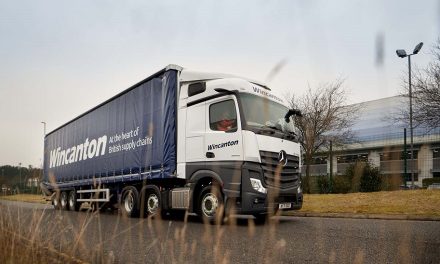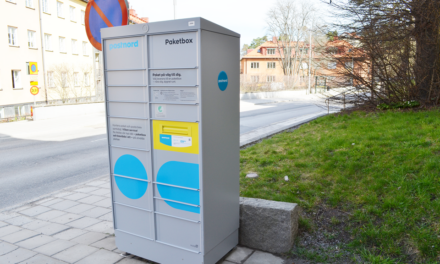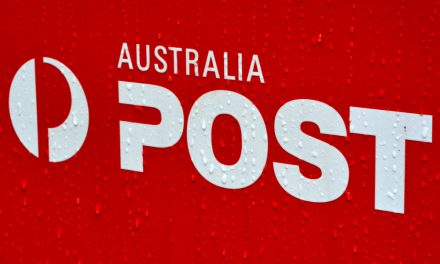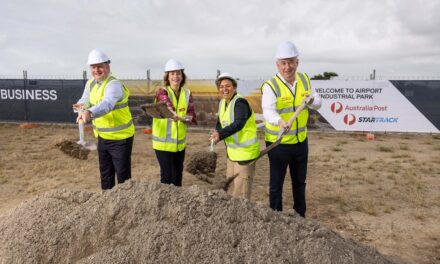
Graeme John transformed Australia Post culture and profitability
In just 10 years, Graeme John has transformed Australia Post's culture and profitability.
Early on a blustery morning in south-eastern Melbourne, Australia Post managing director Graeme John is in the front seat of a chauffeur-driven Holden. He is enthusiastically extolling the virtues of the Dandenong mail centre in Victoria, one of the biggest and most advanced in Australia. Near the centre, he stops and interrupts himself with a mild expletive. On the other side of the road is an Australia Post vehicle, its doors open, and what appear to be brochures strewn over the verge and road for several metres around. The driver of the vehicle, oblivious to who is watching, is hurriedly retrieving the pamphlets. With obvious relief, John observes that although the brochures have to be retrieved and delivered "at least they're not addressed mail" and his car continues to the gates of the Dandenong facility.
That minor accident highlights two things: first, above all, Graeme John is a postman. His primary objective is to ensure that the mail gets through, as efficiently and quickly as possible. Hence his clear concern that these brochures, although they are not enveloped or individually addressed, must reach their intended destination. Second, had the vehicle spilled its contents on to the roadside 10 years ago, when John took over as managing director, it is unlikely that the driver would have even bothered to stop.
The Australia Post of 1993 was nothing short of a cot case. And one of its biggest problems was staff. A lack of motivation and little or no pride in the organisation permeated employee ranks. The fact that an employee in 2003, unaware he is being observed by his managing director, stops and picks up every last leaflet he has haplessly dropped, points to one of John's most important achievements. Australia Post's workforce has been revolutionised. Productivity is at levels that John could only imagine in 1993, and the industrial relations picture – although not quite perfect – is Unrecognisable compared with its pitiful state a decade ago.
John says: "If I have a philosophy, it is 'just imagine'. When I took over as managing director in 1993, I thought, 'just imagine what this organisation could be'. But it wasn't just up to me, and I've tried to pass that outlook throughout [the workforce], by encouraging all staff to be innovative, creative and motivated." Australia Post at that time was plagued – justifiably, as John acknowledges – with a Public Service image of being slow-moving, with a dull range of products, and customer service that was indifferent at best. "There is now enormous pride and motivation in the organisation, and staff have positively embraced the changes."
The facts and figures support John's claims. In October this year, 10 years and two months after his appointment, John quietly presented Australia Post's shareholder, the Federal Government, with a set of results that any private enterprise would be proud of.
In the 2002-03 financial year, the company lifted net profit by 11.8% to $330.8 million. Despite a fall in letter volumes of almost 20 million items, to 5.262 billion, Australia Post lifted total revenue by 4.3% to $3.97 billion, thanks in part to the first postage-stamp price increase in 11 years, from 45¢ to 50¢, and strong performances in the company's other businesses, especially its retail and financial services division. The Government received a dividend of $304.3 million, up from $291.8 million a year earlier.
In the past five years, John has overseen a cumulative labor productivity improvement of 23.3 a fall in industrial disputation among the company's 35,400 staff to a negligible level, and an increase in on-time letter delivery performance to 96.5%. John presides over the country's biggest retail network, with 4493 outlets, which serve more than a million customers each day. Ten years ago, the non-postage retail business was losing $140 million. In the latest results, net profit from these operations was $36.2 million, and the company's shops sell an expanded range of products, from stationery to gifts and communications products. In 1993, Australia Post serviced 7.3 million "delivery points" around the country, a figure that has grown to 9.4 million in 2003.
The improvement in Australia Post's performance, and the extraordinary cultural change that has been a big part of it, is formidable. But Graeme John is a formidable man – in every sense. His physical stature is a good starting point: he stands at 190cm, speaks in a boom, and does not look anything like his 60 years. But he is remarkably reticent. He loathes being singled out as responsible for the company's turnaround, and rarely talks to the media. Speaking to BRW was his first media interview in four years.
"I prefer the organisation to speak for itself," he says, referring
frequently to Australia Post as a team, and time and again talking of the achievements of "our people". That he promotes the team mentality is not surprising, given John's background. In the 1960s, he moved from Perth to Melbourne, where he spent five years playing Australian rules for South Melbourne Football Club. He became the club's youngest coach and was subsequently club president.
Football remains a passion, and John is an Australian Football League commissioner. His working life began in transport, and immediately before joining Australia Post in 1990 as the corporation's national operations manager, he had been deputy general manager of TNT. He is reluctant to discuss why he decided to leave TNT to join a bureaucracy, saying only that being presented with a challenging senior role at Australia Post was irresistible, and also daunting.
From the beginning, John saw the need for a comprehensive
cultural shift. "This organisation was operationally focused," he says. "It needed to be converted to a customer service, sales and marketing environment supported by superb operations."
By the time he was elevated to the managing director's job, John had made such a mark on the organisation that when he went to the board to ask for $70 million to develop and install completely new technology across the post office network, he got it, even though Australia Post was a financial disaster area.
Culturally, Australia Post was not only a slow-moving bureaucracy, it was also suffering an identity crisis. Post offices were both retail businesses and mail sorting points, and the front-office functions were operationally at odds with the back office.
"We had competing cultures. The post office manager had to try
to be a retailer, which he wasn't good at, and then had to be a postal deliverer and supervisor," John says. "And because there was a different wage structure between the front office and back office, there was generally a fair amount of acrimony between retail staff and delivery [staff]."
John's solution was to separate the functions. Post offices moved into shopping strips and malls; sorting and delivery functions were moved into commercial areas such as industrial estates. The strategy was the cornerstone of his effort to transform Australia Post into a customer-service focused business. It was achieved with remarkably little industrial trouble. "We have been able to restructure the workforce by relocating a lot of people. We've also had a fair degree of voluntary retirement, but up to now we haven't compulsorily retrenched one person since I've been in the chair."
John has always paid close attention to the human resources area; it is a fundamental concern of his management role. He is happy to talk about Australia Post's expansion opportunities, such as his objective to move into China within two years to establish a logistics operation, but he seems most comfortable talking about the staff initiatives that have been introduced during his tenure.
"We have introduced bonuses for achievements in the workforce, so that people now take home about 1% of their gross income as bonuses. What I still want to do is to develop more team-based structures to reward the best, most creative, most improved – things of that nature. I believe that everybody should be able to make a difference on a day-to-day basis. That's a challenge for me and a challenge for everybody."
It is obvious that John takes great pride in having turned the public attitude to Australia Post from one of scorn to trust and respect, and that it has been achieved through the new customer-focused culture. Nobody recognises more than John the importance of the Australia Post brand, and nobody derives more satisfaction from the 2003 Sweeney Research/Grey Advertising Eye on Australia study of community attitudes, which named Australia Post the country's most trusted company. "The trust and security people have in the Australia Post brand really is fundamental, and it is also a management style that needs to be permeated through the place itself," John says. "It is about listening to people, having a process for grievance control and dispute settling, because if the people can trust their environment and their workmates, then customers are going to acknowledge that."
One of the notable aspects in John's style of management is his ability to switch without blinking from talking up Australia Post's workforce to discussing complex operational issues. Unprompted, he rattles off figures when discussing, for example, the capabilities of the recently completed $117-million Dandenong mail centre. On a typical night it handles six million postal items.
"Large letters and parcels [sorting capacity] has gone from 9000 an hour to 24,000 an hour," he says, while pointing out one of the most technologically advanced sorting machines in the world. He explains every facet of its operation with such ease he gives the impression he would be right at home opening it up and tinkering with it.
It is a complex piece of machinery that has a strong commercial reason for being there. It is part of John's overall effort to increase productivity and keep prices down for Australia Post's gigantic corporate customer base, which ranges from Telstra down to thousands of small and medium-size enterprises. John says: "I had an ambition to have a 20¢ letter, and I still have. Under certain circumstances for [some customers] now we get down to 32¢."
He says his refusal to sanction price increases for business customers has been a key element in keeping mail volumes from falling in the face of intense competition, mainly from e-mail in the past five years. "The cost of business mail has actually come down by between 10% and 12% in the past decade. With the security and quality of service we have provided, we were able to grow the business strongly [between 1993 and 2000]. Growth flattened down then for a couple of years, but it is starting to come back."
The biggest threats to revenue in business mail have come from
e-mail and from consolidation of mailing practices. John points out, for example, that Telstra – Australia Post's biggest customer – has streamlined its billing processes in the past two years so that many customers who would once have received three bills (for mobile, internet and landline) now receive one.
This has made Australia Post look for other postal growth opportunities in its business customer base, and direct marketing has proved a boon. The volume of promotional and advertising material sent out via Australia Post has more than doubled since 1993, from 238 million items to 571 million items in 2003. John says without hesitation that this figure will double again within the next five years.
Australia Post actively promotes direct marketing, and John is dismissive of its negative image. He says a survey by the marketing consultants Epiphany late last year showed that direct mail was the form of communication most likely to stimulate customers. "That confirmed what we already knew. It was quite remarkable but it wasn't news to us," he says.
It is dangerous to single out one area, such as direct marketing, where John is confident about growth, simply because Australia Post now has such a wide portfolio of products and services. For example, the company's logistics business offers integrated logistics and fulfilment services such as order processing, credit management, warehouse and inventory management.
Revenue from the logistics business grew by a whopping 92.8%
in 2002-03, helped in part by a contract John likes to mention: in 2001, Australia Post was contracted by Microsoft to handle the entire Australian supply chain for its Xbox computer game console, and 2002-03 marked the first full year of that deal. "We have a bonus arrangement where if we perform to a certain standard for [Microsoft], we receive the maximum bonus. We have had the maximum bonus." The Xbox contract was the first of its type for Australia Post, and earlier this year it signed a supply chain deal with the 130-store retail chain Best & Less.
John revels in the fact that Australia Post is now such a diverse business. As long as each division can make an acceptable return, it is a case of the more the better. "Once upon a time when we walked into a prospective customer, like a bank or an insurance company, or an SME, we would just say, 'Give us your letters'. We can now go to customers and say, 'You can outsource your stationery supply, you can outsource your direct marketing campaign, all your accounts, and we'll manage your ledgers for you. We will do all your printing for you and will distribute all your marketing products and handle all your logistics. Oh, and by the way, we'll manage your mail room for you, and if you really like, we'll connect you up to corProcure [Australia Post's e-commerce network] and you can do all your purchasing through that too'. When you finish telling them all that, people sit there and say, 'Shit, it's not a bad idea for Australia Post to do all that for us, so why not?' "
Australia Post – key facts
Financial
* Total revenue in 2002-03 increased by 4.3% to $3.97 billion. Letters accounted for 50.7% of revenue; parcels 14.4%; retail and financial services 13.7%; and international 11%.
* Of additional revenue during the year, more than 60% related to volume growth in non-mail areas.
* Net profit rose by 11.8% to $330.8 million. In the five years since 1998-99, net profit has risen by an average of 9.5% a year.
* In 2002-03, domestic letter volumes fell by 0.3 as a result of strong competition from e-mail and a rise in the price of a stamp from 45¢ to 50¢, the first increase in 11 years. But as a result of the price increase, letter revenue rose by 2.4%. On-time letter delivery reached 96.5%, according to an audit by KPMG, compared with 93% in 1993.
* Managing director Graeme John says letter volume has increased in the first quarter of 2003-04 compared with the comparable period last year.
Operations
* Australia Post has the nation's
biggest retail network, with 4493 outlets (2588 in rural or remote areas). Retail revenue grew by 11.1% in 2002-03
(the dollar figure was not specified). Retail product net profit was $36.2 million. The strongest product growth came in mobile telephony, which recorded a 50% growth in revenue, mainly from the sale of handsets and pre-paid recharge cards. The company expects strong revenue growth from communications products to continue.
* Australia Post is the nation's
biggest financial transaction business.
In 2002-03, it processed 171 million bill payments, compared with 167 million a year earlier. It has bill-paying access
for 511 businesses, and in 2002-03 collected $73.1 billion in bill payments. A total of 76 financial institutions are members of the giroPost banking service, which accounted for 33.7 million transactions during the year.
n In March this year the company added Western Union Money Transfer to its services.
Staff
* Industrial disruption was minimal during 2002-03, at 10 days per 1000 employees.
n Productivity growth for the year was 3.8 bringing cumulative productivity improvement since 1998-99 to 23.3 double the national companies average.
GRAEME JOHN, AO
Position: Managing director, Australia Post
Appointed:
August 1993
Age: 60
Lives: Melbourne
Career: John joined Australia Post as national operations manager in 1990 after a 28-year career in line management for road, rail and sea transport. Immediately before joining Australia Post, he was deputy general manager at TNT.
Management style:
"I have always,
to the best of my ability, run [Australia Post] as a private-enterprise organisation. I don't say this egotistically, but there probably aren't many post organisations around the world at the moment as good as we are. I take a fair amount of pride in the statistics of what this business would be worth. [In 2002-03] we made earnings before interest and
tax of $462 million.
At about 10 times that, you are looking at a business worth between $5 billion
and $6 billion. Most of all, I take pride in the people in this organisation, who have embraced change positively and with terrific commitment along that journey and, as we improve their environment, so will their contribution continue to improve."













